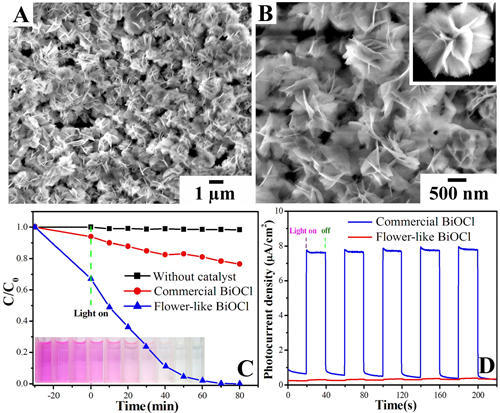As a kind of semi-conducting material with excellent photocatalytic activity, BiOCl has been a hot topic in phtotcatalysis area. Studies show that the morphology and exposed crystal planes of BiOCl have significant influence on its photocatalytic activity.
Compared with conventional nano particles, three-dimensional (3D) BiOCl hierarchitectures composed of nano sheets show better photocatalytic activity due to their large surface area. However, the current method to prepare BiOCl three-dimensional hierarchitectures has certain limitations. Therefore, how to synthesize BiOCl photocatalytic materials with hierarchitectures under room temperature has become a challenge.
 |
|
SEM, photocatalytic activities and photoelectric conversion performances of flower-like BiOCl hierarchical nanostructures (Image by BI Yingpu et al.) |
The research group for energy and nano catalytic materials for environment at Lanzhou Institute of Chemical Physics (LICP) of the Chinese Academy of Sciences (CAS) has fabricated 3D flower-like BiOCl hierarchical nanostructures (HNs) by a facile and rapid in situ oxidation reaction between metallic Bi nanospheres and FeCl3 at room temperature. The resulting flower-like BiOCl hierarchical nanostructures exhibit much higher visible-light-driven photocatalytic activity and photoelectric property than commercial BiOCl. The rational in situ oxidation fabrication of Bi-based semiconductor hierarchical nanostructures may be an effective technique for the development of highly efficient visible-light-sensitive photocatalysts.
The work has received support from the National Natural Science Foundation of China . The work has been published in Chem Eur J(Chem Eur J, 2013, 19, 9472).


